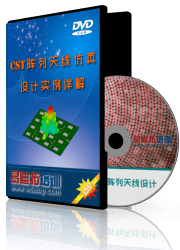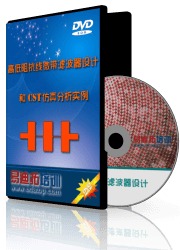- 易迪拓培训,专注于微波、射频、天线设计工程师的培养
Dielectric Resonator Filter - CST2013 MWS Examples
Without AR-filter: | |
With AR-filter: |

General Description
This filter is build up by a metallic box, including two cylindrical, dielectric insertions. Elongated inner conductors of two coaxial lines are the input and the output of the structure.
The two dielectric discs act as coupled resonators such that the entire device becomes a high quality band pass filter.
The structure is simulated twice with the transient solver, with and without applying the online AR-filter analysis.
The same structure has also been simulated with three types of Frequency Domain solvers: the general purpose hexahedral and tetrahedral as well as the resonant hexahedral solver.
Structure Generation
The most important parts of the structure are modelled by cylinders. The coaxial lines as well as the dielectric discs are of cylindrical shape. Only the metallic ground plane where the coaxial ports are located and the surrounding space are bricks.
For the real world structure there is a metallic box that encloses the structure. For the simulation, this box is omitted, because it can be simulated by electric boundary conditions.
Solver Setup
Because of the symmetry of the structure a magnetic symmetry condition is used (Only one half of the structure needs to be simulated to obtain the results of the entire structure).
The example has been calculated twice (resonator1 and resonator2): The first one is simulated with a default solver setup, while the second uses AR-Filtering to reduce the simulation time. Here the simulation can be stopped quite early because the remaining signal can be predicted by a digital filter.
Post Processing
The scattering parameters and the time signals can be accessed through the 1D Result folder in the navigation tree. The results there can also be selected during the simulation.
In the second example the scattering parameters calculated by the AR-Filter can be seen under 1D Result in all folders with the suffix "(AR)".
Also an electric field monitor has been set up to visualize the fields at the center frequency of the filter. Select 2D/3D Results  E-Field
E-Field  e1 to obtain the field plot in the main view.
e1 to obtain the field plot in the main view.
CST微波工作室培训课程套装,专家讲解,视频教学,帮助您快速学习掌握CST设计应用
上一篇: BGA Package - CST2013 MWS Examples
下一篇: Coaxial Connector (Thermal) - CST2013 MWS Examples
CST涓枃瑙嗛鍩硅鏁欑▼ | More...
 最全面、最专业的CST微波工作室视频培训课程,可以帮助您从零开始,全面系统学习CST的设计应用【More..】
最全面、最专业的CST微波工作室视频培训课程,可以帮助您从零开始,全面系统学习CST的设计应用【More..】
频道总排行
- Rectangular Waveguide Tutorial
- FSS: Simulation of Resonator
- CST2013 MWS Examples: Thermal C
- Dipole Antenna Array - CST201
- CST MWS Examples - CST2013 M
- Microstrip Radial Stub - CST2
- Dielectric Resonator Antenna -
- Interdigital Capacitor - CST20
- CST2013 MWS Examples: Biological
- Lossy Loaded Waveguide - CST2










